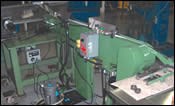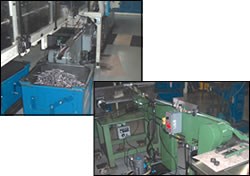Multipurpose Part Conveyor
Most part conveyors will collect machining fluid as it drains from moving parts, but here's one with more versatility.
Most part conveyors will collect machining fluid as it drains from moving parts, but here's one with more versatility. The multi-use part-handling conveyor from DRH Performance Engineering (Reed City, Michigan), also applies a cleaning fluid, then blows it off, adds a rust inhibitor and even carries parts to a packaging station. It was originally designed to handle and clean small shafts produced in high volumes on multi-spindle Wickman automatics, but has also been adapted to centerless grinders, rotary transfer machines and multi-spindle New Britain automatics. In the latter applications, the conveyor is used to clean the parts and/or apply a rust inhibitor.
Available in lengths from 4 to 12 feet, the conveyor quickly and easily adjusts to the height of the production machine. The conveyor is powered by a 1/3-hp motor. Its belt speed can be adjusted to match the output of the production machine. The link-type belt is available in widths from 2 to 12 inches in 2-inch increments and comes with a non-marring coating. (Non-marring side rails provide additional protection for fragile parts.) The unit features ¼-inch-thick aluminum plate construction throughout. Basic units weigh 100 to 125 pounds and are easily portable. Utility requirements for basic units are 115-volt AC and compressed air. Plumbing is supplied with the system.
Models start with a basic unit 4-feet to 6-feet long that applies a single fluid (for example, a mineral spirit wash), followed by a blow off. A 7-foot unit provides blow off of the machining fluid and its collection in a pan, a fluid application and blow off of the fluid.
Units 8- to 12-feet long can feature blow off of the machining fluid, application of a fluid, blow off of the fluid and application and blow off of a second fluid such as a rinse or rust inhibitor. A major design goal for the larger units was to permit the use of two different processing fluids with minimal intermixing, making their recovery and reuse possible. Even modest improvements in extending fluid use can result in appreciable savings.
DRH is currently developing an 8-foot-long conveyor with an aqueous cleaning system. The conveyor features stainless steel construction and is supported on a large base tank with integral pockets that facilitate moving the unit with a pallet jack or fork lift. The conveyor stages include a blow off of the machining fluid, application of an aqueous soap, a blow off, a rinse and a final dry by a regenerative blower.
Although DRH offers custom installation of the conveyor, maintenance personnel can easily handle the job. Once installed, the conveyor can be moved easily for use elsewhere in the plant and can be used on other production machines with only minor modifications.
Related Content
-
Reinventing the Wheel with Robot-Automated CNC Multitasking
One race team discovers how to efficiently manufacture a new wheel nut design for the next-generation NASCAR stock car with the help of a CNC mill/turn and a built-in robot.
-
Pursuit of Parts Collector Spearheads New Enterprise
While searching for a small parts accumulator for Swiss-type lathes, this machine shop CEO not only found what he was looking for but also discovered how to become a distributor for the unique product.
-
Tips for Troubleshooting and Repairing Chip Conveyors
A nonfunctioning chip conveyor can cause a high-production machine to be down for an extended period of time. Here is some troubleshooting advice if you’re having issues with your chip conveyors.











.png;maxWidth=300;quality=90)







